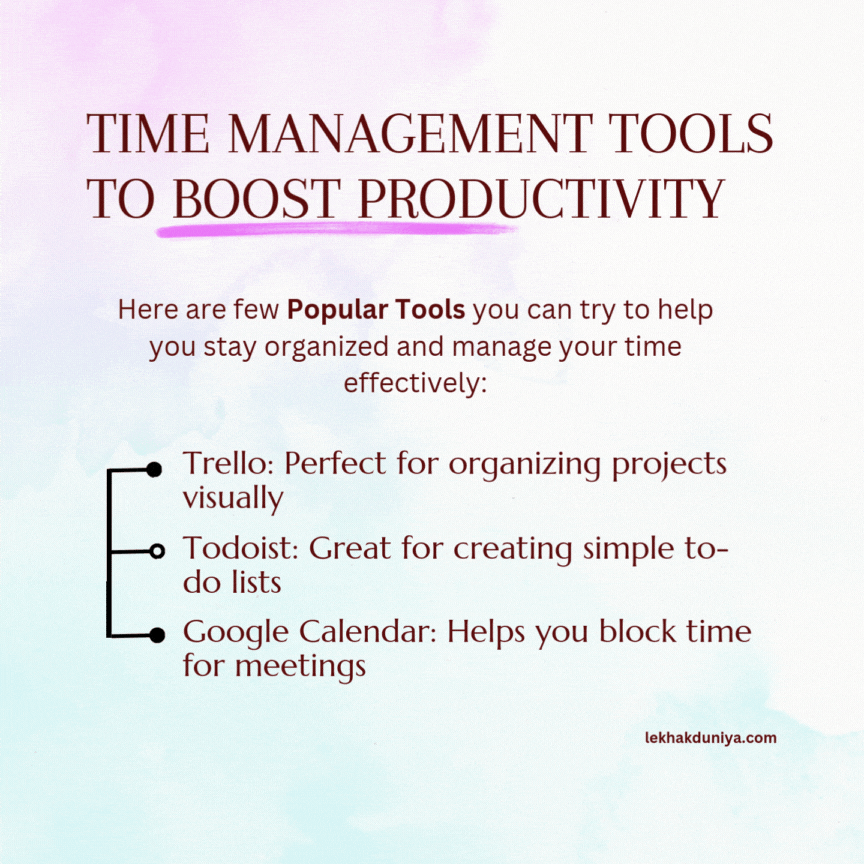Why Time Management Matters
Time is one of the most valuable resources we have, but it’s also one of the easiest to lose track of. Each day comes with only 24 hours, and how we choose to use that time directly impacts our productivity, stress levels, and overall well-being. If you often find yourself wondering where all your time went, you’re not alone—many people struggle with managing their time effectively.

The good news is that with the right strategies for better time management, you can take control of your schedule, boost productivity, and reduce stress. Whether you’re a busy professional, a student, or someone looking to balance personal and work commitments, mastering time management is key to achieving your goals.
Table of Contents
In this blog post, we’ll walk through eight actionable strategies for better time management to help you make the most of your time and get things done efficiently. Ready to regain control of your day? Let’s dive in!

1. Set Clear Goals and Priorities
One of the biggest obstacles to effective time management is not having a clear direction. When you don’t know exactly what you’re working toward, it’s easy to feel overwhelmed and lose focus. That’s why setting clear goals is one of the core strategies for better time management.
Use SMART Goals
The first step to improving your time management is setting SMART goals—goals that are Specific, Measurable, Achievable, Relevant, and Time-bound.
For example, instead of a vague goal like “I want to get healthier,” create a SMART goal like, “I will exercise for 30 minutes, four times a week for the next month.” This clarity gives you a roadmap to follow and ensures that your time is used effectively.
Prioritize Using the Eisenhower Matrix

After setting your goals, the next step is learning how to prioritize tasks effectively. A great tool for this is the Eisenhower Matrix, which helps you organize your tasks based on urgency and importance. By breaking tasks into four simple categories, you can decide what to focus on first, what to schedule for later, and what to delegate or skip altogether:
- Do First (Urgent and Important): Tasks that need immediate attention, like meeting deadlines, revert to an important email.
- Schedule (Important but Not Urgent): Tasks that contribute to long-term goals but don’t require immediate action, like planning or personal growth, which you can schedule for later.
- Delegate (Urgent but Not Important): Tasks that need to be done but don’t contribute significantly to your goals, like attending certain meetings.
- Eliminate (Not Urgent or Important): Activities that don’t add value, like excessive social media scrolling, which you can minimize or remove.
By using this matrix, you’ll gain clarity on what truly deserves your time, ensuring your energy goes toward the tasks that matter most.
2. Create a Daily Schedule with Time-Blocking
Without a structured plan, it’s easy to get lost in the day’s tasks. That’s why creating a daily schedule is one of the most powerful strategies for better time management.
The Time-Blocking Method

A highly effective way to organize your day is by using the time-blocking method. This approach breaks your day into dedicated time slots, with each slot focused on completing a specific task or related activities. For example, you might block out 9:00 AM to 11:00 AM for deep work and 1:00 PM to 2:00 PM for meetings or collaboration.
By assigning tasks to specific time slots, you can focus on one thing at a time without getting overwhelmed by everything else on your to-do list. Time-blocking also helps you avoid multitasking, which studies show can reduce productivity.
Creating a daily schedule using time-blocking is one of the most effective strategies for better time management because it helps you stay organized and focused throughout the day.
3. Limit Distractions to Stay Focused
Distractions are one of the biggest time thieves. Whether it’s constant notifications from your phone or being pulled into unnecessary meetings, distractions can quickly derail your focus.

Common Distractions and How to Avoid Them
Some of the most common distractions include:
- Social media
- Email notifications
- Phone calls or texts
- Loud or busy environments
To limit these distractions, consider using tools like Focus@Will or StayFocusd to block distracting websites and apps during work hours. Try the Pomodoro Technique, where you work intensely for 25 minutes, take a quick 5-minute break, and repeat—helping you stay focused without feeling overwhelmed. This method keeps you focused and helps avoid burnout during longer work sessions.
Minimizing distractions is one of the most practical strategies for better time management. By staying focused, you’ll get more done in less time.
4. Learn to Say No and Create Healthy Boundaries
Do you say yes to tasks or commitments, even when you don’t have the time? While it might feel good to agree to everything, it often leads to burnout, frustration, and a loss of control over your schedule. One of the most effective strategies for better time management is learning to say no and setting healthy boundaries.
Why Saying No is Important
Every time you say yes to something that doesn’t align with your priorities, you’re effectively saying no to something more important—focusing on your work, pursuing personal goals, or simply taking time for yourself. Saying no doesn’t mean you’re unhelpful or selfish. It’s about valuing your time and energy and dedicating them to what truly matters.

How to Say No Gracefully
Saying no doesn’t have to feel uncomfortable. You can decline politely by:
- Being honest and clear: “I appreciate you asking, but my schedule is packed at the moment.”
- Suggesting alternatives: “I’m unable to take this on right now, but maybe [another person or solution] could assist?”
- Use a delay tactic: “Let me check my schedule and get back to you.” This gives you time to evaluate whether the request fits your priorities.
Set Boundaries That Work for You
Setting boundaries is another critical part of managing your time. Boundaries help you avoid being pulled in too many directions, whether saying no to after-hours work emails or carving out specific hours for family or personal time. Communicate your boundaries clearly with colleagues, friends, and family so they understand and respect your limits.
By confidently saying no and setting boundaries, you can protect your time and energy, making it easier to focus on tasks that align with your goals. This simple but powerful habit is one of the most effective strategies for better time management.
5. Leverage Time Management Tools to Boost Productivity
Sometimes, managing your time feels like juggling too many balls in the air. That’s where time management tools can come to your rescue. These digital tools are like personal assistants, helping you organize your tasks, schedule your day, and even remind you of deadlines.
Why Time Management Tools Matter
Using tools isn’t just about staying on top of tasks—it’s about freeing your mind from the clutter of remembering every little detail. When you have a system in place, you can focus more on doing the work rather than figuring out what needs to be done next.

Popular Tools You Can Try
Here are a few tools to help you stay organized and manage your time effectively:
- Trello: Perfect for organizing projects visually with boards, lists, and cards. Whether it’s a work project or a personal goal, Trello keeps everything in one place.
- Todoist: Great for creating simple to-do lists, setting priorities, and tracking your progress. It’s user-friendly and seamlessly works across all your devices.
- Google Calendar: A classic tool that helps you block time for meetings, tasks, and personal commitments. Try using different colors to categorize your activities, making it easier to identify tasks at a glance.
Maximize the Benefits of These Tools
Start with one tool that feels right for your needs. For example, if you often forget deadlines, a tool like Google Calendar can help you set reminders. On the other hand, if you need to break a big project into smaller steps, Trello might be your best bet. The key is consistency—stick to your chosen tool and make it part of your daily routine.
Incorporating time management tools into your day is one of the easiest strategies for better time management. With the right tool in your corner, you’ll spend less time stressing about what to do next and more time getting things done.
6. Break Tasks into Smaller Steps
When faced with a large project, it can be tempting to put it off because it feels overwhelming. A simple solution is to break down large tasks into smaller, more manageable steps. This makes even the most daunting projects easier to tackle.
For example, instead of writing “Complete project proposal” on your to-do list, break it down into steps like “Research background,” “Draft outline,” and “Write introduction.”
Breaking tasks into smaller, manageable steps helps you stay productive and make steady progress without feeling stressed or overwhelmed. This is one of the strategies for better time management that helps you approach tasks methodically and avoid procrastination.
7. Monitor Your Time and Refine Your Approach
To improve how you manage your time, it’s essential to regularly monitor your activities and assess your progress. Use tools like Toggl or Rescue – Time to track how you’re spending your time. This insight helps you identify inefficiencies, like spending too much time on low-priority tasks.
Once you know where adjustments are needed, refine your approach by focusing on tasks that align with your goals. This process of reviewing and tweaking ensures that your time management strategies evolve with your needs, making them even more effective over time.
For instance, if you notice you’re spending too much time checking emails, set specific times throughout the day to handle emails and stick to that schedule. Tracking your progress ensures that you’re continually improving your time management skills, which is one of the most critical strategies for better time management.
8. Make Time Management a Habit
Developing better time management skills isn’t something that happens overnight—it’s a habit that you build over time. By consistently applying these strategies for better time management, you’ll not only get more done but also feel more in control of your day.

Start by incorporating one or two strategies into your routine, then gradually add more as they become habits. Over time, these small changes will lead to significant improvements in your productivity and overall well-being.
Final Thoughts: Take Control of Your Time
Mastering strategies for better time management is one of the most powerful ways to increase your productivity and reduce stress. By setting clear goals, creating a structured schedule, limiting distractions, and using the right tools, you can take control of your time and accomplish more every day.
Remember, time management is a skill that takes practice, but with consistency, it will become second nature. Begin with small steps, monitor your growth, and fine-tune your methods along the way. With these strategies, you’ll not only manage your time better but also achieve your goals and enjoy a more balanced, fulfilling life.




Baddiehub Good post! We will be linking to this particularly great post on our site. Keep up the great writing
This web site is really a walk-through for all of the info you wanted about this and didn’t know who to ask. Glimpse here, and you’ll definitely discover it.